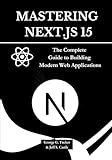Best Dynamic Routing Guide to Buy in December 2025

Mastering Next.js 15: The Complete Guide to Building Modern Web Applications



Learn Next.JS: Guide to Next.JS



Learn React with TypeScript: A beginner's guide to building real-world, production-ready web apps with React 19 and TypeScript



The Road to Next: Full-Stack Web Development with Next.js 15 and React.js 19 (2025 Edition)



The Developer’s Guide to RAG with Next.js and LangChain: Unlock Custom AI Search and Chat Features for Docs, Notion, and More—From Ingestion to Deployment



What's Next?: The Journey to Know God, Find Freedom, Discover Purpose, and Make a Difference



The Complete Front-End Interview Guide: Angular, Node.js, React, Next.js, Vue.js, & TypeScript: Master the Fundamentals and Advanced Concepts, Become a Front-End Expert with Comprehensive Interview


Dynamic routes in Next.js allow you to create pages that use URL parameters to dynamically generate content. This feature is useful when you want to create pages that share a similar layout or template but display different data based on the URL.
To use dynamic routes in Next.js, you need to follow these steps:
- Create a file inside the "pages" directory with square brackets in the filename. For example, if you want to create dynamic product pages, create a file called "products/[id].js".
- Inside this file, export a single function called "getServerSideProps" or "getStaticProps" that fetches the necessary data for the page. This function will receive a parameter called "context" which contains information about the current request, including the URL parameter value.
- Within the function, retrieve the URL parameter value by accessing the "context.params" object. For example, if you have a parameter called "id", you can access it using "context.params.id".
- Fetch the necessary data from an API or a database based on the parameter value.
- Return an object with the fetched data from the "getServerSideProps" or "getStaticProps" function. This data will be passed as props to the page component.
- Create a React component in the same file to render the dynamic content using the fetched data from props.
That's it! Next.js will automatically handle the routing and pass the URL parameter value to your page component as props. You can then use this value to generate dynamic content or customize the layout.
Dynamic routes in Next.js are powerful and flexible, allowing you to create dynamic pages easily while ensuring good performance and SEO optimization.
How to deploy Next.js dynamic routes to a production environment?
To deploy Next.js dynamic routes to a production environment, follow these steps:
- Build your Next.js application by running the command npm run build or yarn build in your project's root directory. This will generate an optimized production-ready bundle.
- Make sure you have a production-ready server to run the Next.js application. You can use frameworks like Express.js or deploy the Next.js application to a serverless environment like Vercel or AWS Lambda.
- Copy the entire contents of the .next directory generated after the build, except the .next/cache directory, to your production server.
- Configure your production server to serve the Next.js application. If you are using Express.js, you can use the following code snippet:
const express = require('express'); const next = require('next');
const dev = process.env.NODE_ENV !== 'production'; const app = next({ dev }); const handle = app.getRequestHandler();
app.prepare().then(() => { const server = express();
server.all('*', (req, res) => { return handle(req, res); });
server.listen(3000, (err) => { if (err) throw err; console.log('> Ready on http://localhost:3000'); }); });
Replace server.listen(3000) with the appropriate port on which you want to run your application.
- If you are deploying to a platform like Vercel, the deployment process will automatically handle the server configuration, and you can skip step 4.
- Test the deployment by visiting your site on the specified port. The dynamic routes should now be available in the production environment.
Remember to follow the deployment guidelines of your hosting platform for specific instructions on deploying Next.js applications.
How to implement pagination with dynamic routes in Next.js?
To implement pagination with dynamic routes in Next.js, you can follow these steps:
- Create a new dynamic route in the pages directory. For example, create a file pages/posts/[pageNumber].js to handle pagination for posts.
- In the dynamic route file, import the necessary data for the page. You can fetch data from an API, a database, or any other source.
- Implement the getStaticPaths function in the dynamic route file. This function generates all possible paths for the pages using a range of page numbers. For example:
export async function getStaticPaths() { const totalPages = await getTotalPages(); const paths = [];
for (let page = 1; page <= totalPages; page++) { paths.push({ params: { pageNumber: page.toString(), }, }); }
return { paths, fallback: false, }; }
Note that the fallback property is set to false to ensure that only the generated paths are accessible.
- Implement the getStaticProps function in the dynamic route file to fetch the specific data for the current page number. For example:
export async function getStaticProps({ params }) { const pageNumber = parseInt(params.pageNumber); const posts = await getPosts(pageNumber);
return { props: { posts, }, }; }
Here, getPosts is a function that fetches posts for a specific page number.
- In your component, you can access the posts data through the props and render it.
Now, when you navigate to a paginated URL like /posts/2, Next.js will statically generate the page by fetching the required data based on the page number.
Keep in mind that if the number of pages is too large or dynamic, you may need to consider other pagination techniques, such as implementing server-side rendering (SSR) with getServerSideProps instead of getStaticProps.
How to create a dynamic route in Next.js?
To create a dynamic route in Next.js, follow these steps:
-
Create a new file inside the pages directory with the desired route pattern. For example, if you want to create a dynamic route for individual blog posts, create a file called [slug].js.
-
Inside the newly created file, export a React component as the default export. This component will be rendered for the dynamic route.
-
Inside the exported component, fetch the data you need for the dynamic route. You can use Next.js's getStaticPaths and getStaticProps functions for this. getStaticPaths is used to specify the possible values for the dynamic parts of the route. It returns an array of objects with params property. Each object represents a possible value for the dynamic part. getStaticProps is used to fetch the data for a specific value of the dynamic part. It receives the params object with the dynamic value and returns an object with the fetched data. Here's an example implementation: import { useRouter } from 'next/router'; export default function BlogPost({ post }) { const router = useRouter(); if (router.isFallback) { return
Loading...
; } return (
{post.title}
{post.content}
); } export async function getStaticPaths() { // Fetch the possible values for the dynamic part (e.g. slugs of blog posts) const res = await fetch('https://api.example.com/blog/posts'); const posts = await res.json(); const paths = posts.map((post) => ({ params: { slug: post.slug }, })); return { paths, fallback: true }; } export async function getStaticProps({ params }) { // Fetch the data for a specific value of the dynamic part const { slug } = params; const res = await fetch(`https://api.example.com/blog/posts/${slug}`); const post = await res.json(); return { props: { post } }; } In the example above, the getStaticPaths function fetches the possible slugs of blog posts from an API and returns them as an array of objects. The getStaticProps function fetches the data for a specific slug from the API and returns it as the post prop.
-
Finally, you can use the dynamic route in your application by navigating to a URL that matches the dynamic pattern. For example, if you have a blog post with the slug "my-first-post", you can visit the URL /my-first-post to see the content of that post.
Note: Dynamic routes using Next.js can also be created using getServerSideProps or by using useRouter and query to fetch data at runtime. However, for performance, it's recommended to use getStaticPaths and getStaticProps when possible.
What are the differences between Next.js's useRouter and Next/router for dynamic routes?
In Next.js, there are two primary ways to handle dynamic routing:
- useRouter: It is a hook provided by the next/router module. The useRouter hook gives an easy way to access the Next.js route object. It allows you to access the current route information, such as the route path and query parameters, without explicitly importing the router instance. It is typically used in functional components to get access to the router.
Example usage:
import { useRouter } from 'next/router';
function MyComponent() { const router = useRouter(); const { id } = router.query;
// Use the id parameter in your component logic // ...
return ( // JSX code ); }
- Next/router: It is an instance of the next/router module. Instead of using the useRouter hook, you can import and use the router instance explicitly in your code. It provides various methods and properties to handle routing, such as router.push(), router.replace(), router.query, etc. It is used to programmatically navigate between pages or access the query parameters directly.
Example usage:
import { useRouter } from 'next/router';
function MyComponent() { const router = useRouter(); const { id } = router.query;
// Use the id parameter in your component logic // ...
return ( <button onClick={() => router.push(`/page?id=${id}`)}>Go to page ); }
In summary, while useRouter is a convenient hook to extract route information within functional components, next/router gives more flexibility for programmatically navigating or accessing route information from any part of your code.
What is the role of the fallback attribute in getStaticPaths for dynamic routes in Next.js?
The fallback attribute in getStaticPaths is used to control how Next.js handles incoming requests to dynamic routes that are not yet statically generated.
When fallback is set to false, Next.js will return a 404 page for any paths that are not specified in the paths array returned by getStaticPaths. This means that if a user requests a page that has not been pre-rendered at build-time, Next.js will show a "page not found" error.
When fallback is set to true, Next.js will attempt to generate the requested page on-demand if it hasn't been pre-rendered. This means that if a user requests a page that hasn't been pre-rendered, Next.js will dynamically generate it on the server and return the generated page. In subsequent requests, the generated page will be served from the cache.
When fallback is set to 'blocking', Next.js will also attempt to generate the requested page on-demand if it hasn't been pre-rendered. However, in this case, Next.js will wait until the page is generated before returning the response to the user. This can be useful for pages that take longer to generate, as it ensures that the user sees a fully generated page instead of a loading state.
Note that when using fallback: true or fallback: 'blocking', a special router.isFallback property will be true inside the page component during the fallback state. This allows you to show a loading state or different content while Next.js is generating the page.
What is the role of API routes in handling dynamic routes in Next.js?
API routes in Next.js are responsible for handling dynamic routes by providing server-side functionality for fetching and manipulating data. They allow you to create custom server endpoints within your Next.js application.
When a request is made to an API route, Next.js invokes the corresponding function that you define in the API file. This allows you to perform server-side rendering, serverless functions, or handle database operations, among other things.
API routes are especially useful for handling dynamic routes. For example, if you have a dynamic route /users/[id], you can create an API route /api/users/[id].js that handles requests for data related to a specific user.
By combining API routes with dynamic routes, you can create powerful client-server interactions in your Next.js application.
How to set up dynamic routes in Next.js?
To set up dynamic routes in Next.js, follow these steps:
- Create a new file in the pages directory with the name [slug].js, where slug represents the dynamic parameter name.
- Inside the [slug].js file, export a React component that will be rendered when the dynamic route is accessed.
- Handle the dynamic route data by using the getStaticPaths and getStaticProps functions.
Here's an example of setting up dynamic routes with Next.js:
- Create a new file named [slug].js in the pages directory.
// pages/[slug].js import React from 'react';
const DynamicPage = ({ slug }) => { return Dynamic Page: {slug}; };
export default DynamicPage;
- Handle the dynamic route data by implementing the getStaticPaths and getStaticProps functions in the [slug].js file.
// pages/[slug].js import React from 'react';
const DynamicPage = ({ slug }) => { return Dynamic Page: {slug}; };
export async function getStaticPaths() { // Define the possible values for slug const paths = [ { params: { slug: 'page1' } }, { params: { slug: 'page2' } }, ];
return { paths, fallback: false, // Enable this if you want to handle fallback cases }; }
export async function getStaticProps({ params }) { // Fetch data for the specific slug const { slug } = params;
return { props: { slug, }, }; }
export default DynamicPage;
In this example, when you access /page1 or /page2, the DynamicPage component will be rendered with the corresponding slug value.
